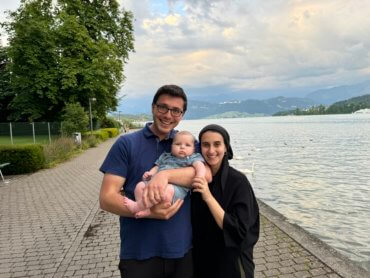
The Gruesome Story My Son Found In the Rosh Hashana Prayer Book
On the way to Rosh Hashana services today, I asked my 11 year old son how his prayers (with his father) the day before had gone. He said he was getting bored, so he started to read the stories below the prayers. He read about the one where the rabbi had his limbs amputated.
I didn’t know what he was referring to, so he opened up the machzor (prayer book) as we walked to synagogue and began to read to me. There’s a troubling prayer Unsaneh Tokef that lists all the ways you could die, and it ends seemingly saying that “repentance, prayer and charity remove the evil decree.” (It’s troubling because it seems to say that we can prevent catastrophes in this world, if we just repent, pray and give charity, but we know the world doesn’t operate in such simplistic ways.)
My son read the origin story of the prayer (which is likely apocryphal but based on actual stories that did occur throughout Jewish history). According to what my son read, the prayer was composed by 11th-century sage Rabbi Amnon of Mainz – a friend of the Archbishop of Mainz. He was pressured to convert to Christianity. As a delaying tactic, he requested three days to consider the offer. Immediately, he regretted giving the idea that he could accept another religion.
After spending three days in prayer, he refused to come to the archbishop as promised, and, when he was dragged to the archbishop’s palace, he begged that his tongue be cut out to atone for his sin.
Instead, the archbishop ordered his hands and legs amputated — joint by joint — as punishment for not obeying his word to return after three days and for refusing to convert. At each amputation, Rabbi Amnon was again given the opportunity to convert, which he refused.
He was sent home, with his severed extremities. This event occurred shortly before Rosh Hashanah. On that holiday, as he lay dying, Rabbi Amnon asked to be carried into the synagogue, where he recited the original composition of Unetanneh Tokef with his last breath. I told my son the origin story of a prayer we have theologically struggled with – seems to disagree with the simple meaning of the prayer. The rabbi prayed and repented but died anyway. Maybe this prayer is not meant to be understood literally.
I also told my son how thankful we should be that Jews are so safe in the world today and as I said that, we arrived at shul and my son noticed the cop car parked out front, as he reminded us both that Jews are still not safe.
I thought about how my son had to find a gruesome story from the past innocently perusing a Jewish prayer book and beefed up security trying to go to a synagogue in our present day and how vicious the lie of Jewish privilege is. My children are deeply proud to be Jews, but our history is laced with tremendous pain and our present feels increasingly precarious.
Having such a blood soaked past and uncertain present is scary enough. Being gaslit that this is not the Jewish reality makes it even worse.
May it be a year of peace, revealed blessings, and finally the end to this violent and painful exile.
If you found this content meaningful and want to help further our mission through our Keter, Makom, and Tikun branches, please consider becoming a Change Maker today.








3 comments
Sort by
Dear Allison! I admire your work very much! I’m your fun. IMHO: We do really believe, that Tshuva, Tfilah and Zdoka helps to save us and whole world. Literatully. Otherwise, why would we pray at all? But Hashem has a plan, which we could not know or fully understand. And we are at the midle of the story of the world at large. That’s why you are not looking on a prayer as people of Bavel. They thought, they can go to heaven and “fix” the sky, so it will be no Mabul again. No. We do our part and Hashem does His, result is not in our hands, but we can influence the outcome. Hashem sends masseges (pain), to show that we should go back to our job: prayer, charity, changes to the good (to work on ourselfs), go back to Him. It’s also we should be loving each other. This is what you do very well.Thanks for helping to make the world a better place!
Hi Mrs Josephs,
Thank you for trying to be a counterbalance to all the negative press coverage of hassidic Jews.
I’m curious why you would say that the story of Rav Amnon of Mainz is “probably apocryphal”?
Considering that this prayer has been said for hundreds years and the story has been repeated for hundreds of years, all by our ancestors of blessed memory who as you know were not easily convinced of anything, you’ve probably noticed the theme of “am kshei oref” a stubborn people repeated in last weeks parsha and throughout the prayers on Yom Kippur. Jews aren’t easily convinced of things, we only believe once we see things and know things to be true, our religion didn’t “evolve” (for more on this topic see kuzari in the first essay).
I know the story of Reb Amnon to be 100% true, just as we know that the Jews in Norwich England were murdered for kidish hashem, we knew this for a fact even though there wasn’t any archeological evidence for 900 years, we didn’t need bodies found at the bottom of a well to know that our traditions handed down for generations are true, our entire existence is based on mesora so it’s important to understand and respect the significance of it.
And lastly I guess this is probably a personal perspective, but I find comfort in the sobering story of Reb Amnon, I love to be part of a people that were willing to sacrifice everything for Hashem, it’s my honor to be part of this group, it gives me strength to know that we will survive, as we have always survived, when put to the ultimate test we remain loyal to Hashem.
Unesane tokef is not problematic, it’s poignant, the basic meaning of teshuvah, tefilla, and tzedakah being zechutim to help overturn a potentially bad judgment are what is core to the Jewish faith, there is reward and punishment, and I think that it also means that even when ultimately we see things happen that seem terrible if we use these 3 things we can remove the “bad” and it makes it possible to see the good, even when going through difficulty. Rav Amnon in the end was ready and proud and happy to give his life for he belief in Hashem, it was the ultimate sacrifice, he withstood the ultimate test and persevered and 900 years later we still say his prayer!
The “bad” of the judgement was certainly removed.
Thanks for your comment. I say apocryphal because after I posted about this, many readers wrote in to say this pray is part of the Cairo Geniza https://rabbidunner.com/the-legend-of-rabbi-amnon-reconsidered/?fbclid=IwAR2Ws-NythdMq4ku9_oJ3_aQ6YOQNs1SJbqhxa1PgukJr7c1D4doi1y38i8
So it’s from a much earlier time and place. In terms of not taking the prayer literally – there’s a real danger in teaching our kids that this formula will literally prevent bad things because they do it and then often bad things still happen. So we have to give over a symbolic or less simplistic reading, lest we hurt children.